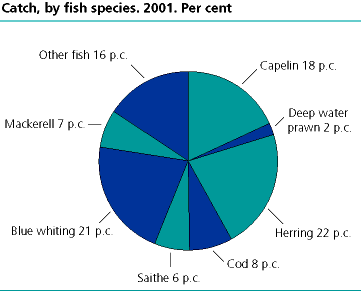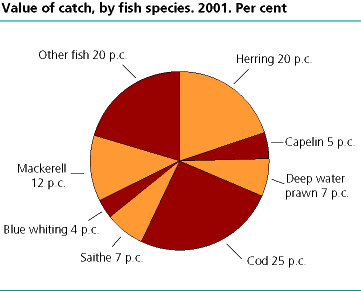Content
Published:
This is an archived release.
Value of catch exceeded NOK 11 billion
Preliminary figures as of 17 January 2002 show that Norwegian vessels delivered 2.6 million tons of fish in 2001, about the same as the preliminary figure for 2000. Including crustaceans and molluscs, the landed value amounted to NOK 11. 2 billion. Compared with 2000 this is an increase of 15 per cent. The increase is due to a rise in the prices of herring and mackerel.
Apart from herring and capelin there has been a slight change in the catch of most species.
In 2001 the catch of capelin increased with 104 000 tons to 479 000 tons.
The herring catch fell from 800 000 tons in 2000 to 575 000 tons in 2001. Landed value of herring increased from 1.4 billion to 2.2 billion. This corresponds to 22 per cent of the total catch and 20 per cent of the total landed value.
The cod catch came to 207 000 tons worth NOK 2.9 billion. This accounts for 8 per cent of the total catch quantity and 25 per cent of the catch value. Among the landed value of catch, the cod fishing is the most important.
Cod and haddock figures include the fishing done from Norwegian vessels on Russian quotas.
Foreign vessels delivered 547 000 tons of fish and crustaceans in Norway in 2001. Value of the foreign landings was NOK 3.3 billion.
Use of the catch
Use of the catch has changed in recent years. In 2001, 41 per cent of the catch was frozen or ground and 43 per cent was made into meal, oil and animal food. Fresh fish accounted for 7 per cent. Five years earlier, only 21 per cent of the catch was frozen, while the percentage of fresh fish came to 29 per cent. The production of meal, oil and animal food has remained at the same level. The entire catch of Norway pout, blue whiting, small sandeel and a large part of the capelin catch are used to manufacture these products.
The statistics are based on data from the Directorate of Fisheries and are released semi-annually.
Tables:
Contact
-
Anne Turi Baklien
E-mail: anne.turi.baklien@ssb.no
tel.: (+47) 48 24 45 30
-
Terje Olav Rundtom
E-mail: terje.olav.rundtom@ssb.no
tel.: (+47) 91 38 60 61


